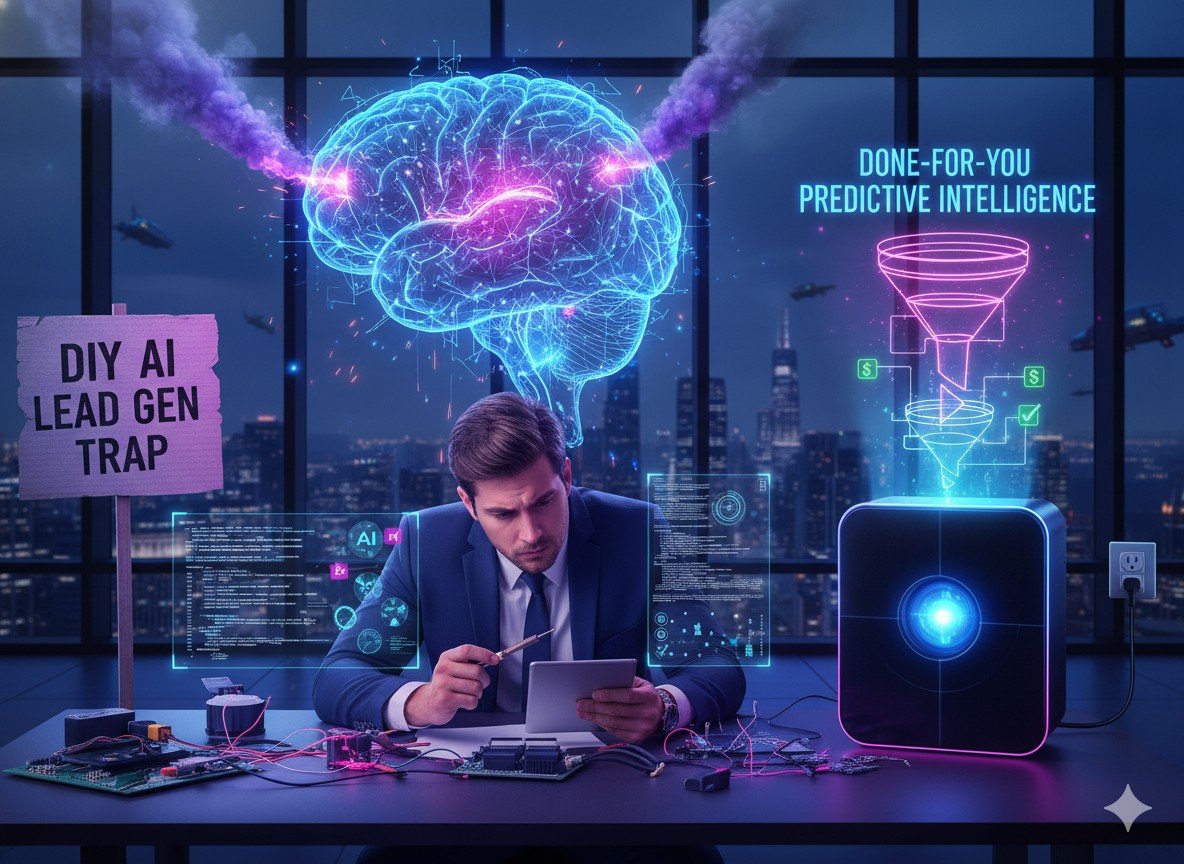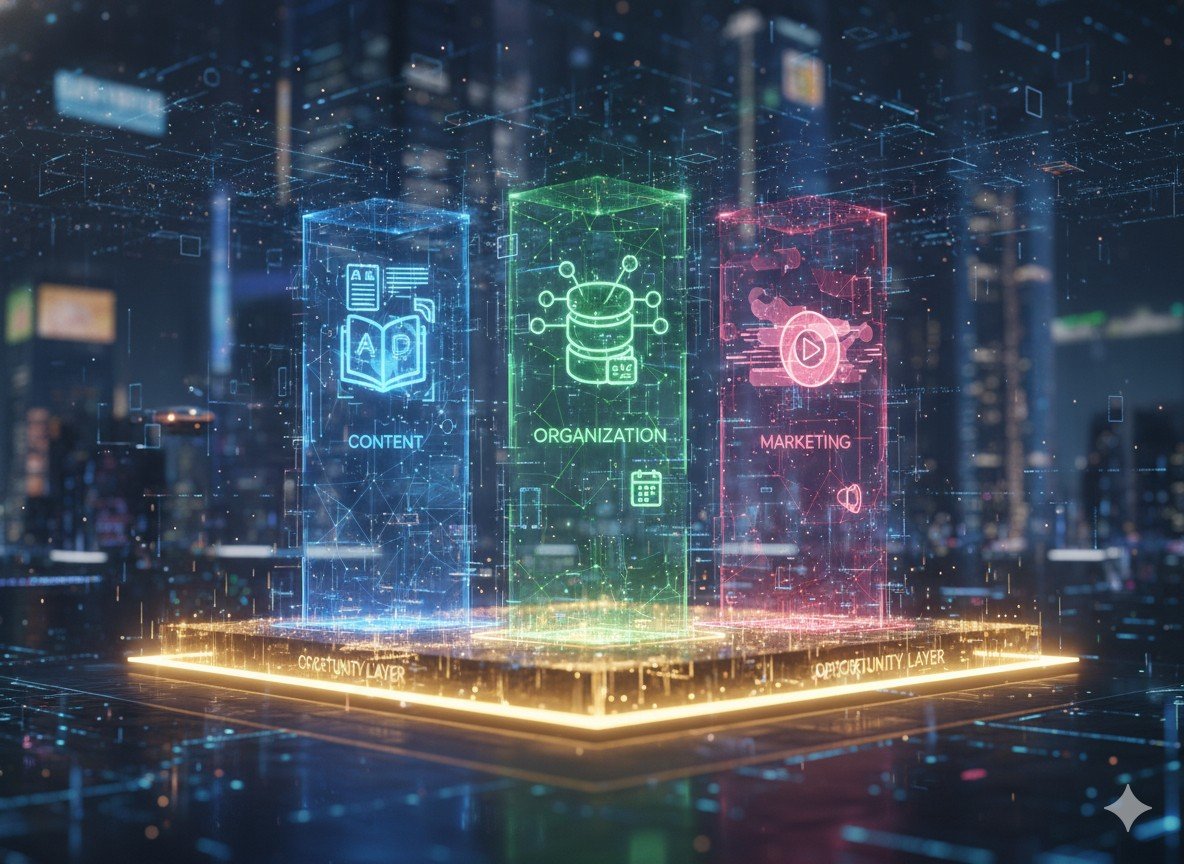Executive Summary: The promise of building an automated lead generation machine using a suite of modern AI tools is alluring for today's real estate professional. However, a detailed analysis reveals that the DIY approach often becomes a costly trap, consuming vast amounts of time and financial resources for an uncertain return. This article provides a comprehensive breakdown of the true, fully-loaded costs of a DIY AI funnel—including hard costs for ad spend and multiple AI tool subscriptions (for copywriting, video, and chatbots) and the significant soft cost of an agent's time. It then presents a direct ROI comparison against a specialized, “Done-For-You” predictive intelligence platform, arguing that an agent's highest and best use is not as a digital marketer or funnel builder, but as a skilled advisor acting on pre-vetted, high-intent opportunities.
1. The Seductive Promise of the DIY AI Funnel
The message is everywhere—on YouTube, in coaching seminars, and across social media. The promise is that any agent can now build a powerful, automated lead generation machine. The recipe seems straightforward: combine the creative power of large language models (LLMs) like OpenAI's ChatGPT, Google Gemini, Anthropic's Claude, or even more specialized models like Mistral or Grok, with a suite of other AI tools for video creation, image generation, and chatbot automation. The vision is a self-sustaining funnel that works 24/7, turning ad clicks into qualified appointments.
This DIY approach is deeply appealing because it offers a sense of control and a path away from the high costs of traditional portal leads. It suggests that with the right collection of tools, any agent can become a master digital marketer. However, this seductive promise often obscures a far more complex and costly reality. Before investing dozens of hours and hundreds of dollars a month into building this machine, a critical analysis of the true, all-in cost is essential.
2. Deconstructing the "Simple" DIY Funnel: A Look Under the Hood
On the surface, the steps to build an AI-powered funnel seem logical. However, executing them requires a significant level of technical integration and, most importantly, a massive investment of an agent's most valuable asset: time. Let's break down what is actually required.
Step 1: Content Creation - The AI-Powered Copy and Creative
The top of the funnel requires compelling content to attract attention. This is where general AI tools are most effective.
- Ad Copy: You use an LLM like ChatGPT or Google Gemini to brainstorm and write dozens of variations of ad copy for platforms like Facebook and Instagram. This involves crafting prompts, refining the output, and ensuring the tone aligns with your brand.
- Visuals: To make the ads stand out, you need images and videos. This may involve using AI image generators like Midjourney or DALL-E to create custom graphics, or AI video platforms like Synthesia or HeyGen to create short, engaging video ads. Each requires a separate workflow of prompt engineering and refinement.
Step 2: The Landing Page & The Hook
Your ads need to point somewhere. This requires a dedicated landing page designed for one purpose: to capture the lead's information. You must create a compelling "lead magnet"—a free guide, a home valuation offer, or a market report—which often requires using your AI copywriter again to generate the content.
Step 3: The AI Chatbot - Your Automated Qualifier
To qualify the inbound traffic from your ads, you integrate an AI chatbot onto your landing page. This requires another subscription and a significant setup process. You must "train" the chatbot on your scripts, define its conversational flows, and create the logic for when to ask for a name, email, and phone number, and when to attempt to book an appointment.
Step 4: The Nurture Sequence - The Automated Follow-Up
Once a lead is captured, it must be nurtured. This requires you to once again use ChatGPT or a similar tool to write a multi-step email drip campaign. You then have to load this campaign into your CRM and set up the automation rules.
When laid out, it becomes clear that this "simple" funnel is a complex, multi-stage marketing operation. It requires the agent to act as a copywriter, a graphic designer, a video producer, a web developer, and a marketing automation specialist. This leads to the core problem: the hidden costs of the DIY approach.
3. The Hidden Costs: Analyzing the True ROI of a DIY Funnel
The true cost of any business strategy is never just the sticker price. A professional analysis requires looking at all three cost categories: hard costs, time costs, and opportunity costs.
The Hard Costs: A Monthly Drain on Your Budget
While many AI tools offer a free tier, building a real, scalable funnel requires paid subscriptions. A realistic monthly budget looks like this:
| Category | Tool Examples | Estimated Monthly Cost |
|---|---|---|
| AI Copywriting | ChatGPT Plus, Jasper, Copy.ai | $20 - $100 |
| AI Video/Image Generation | Synthesia, HeyGen, Midjourney | $50 - $150 |
| AI Chatbot | ManyChat, Tidio, Drift | $50 - $200 |
| Landing Page / Funnel Builder | Leadpages, Instapage | $40 - $100 |
| Subtotal (Tools) | $160 - $550 per month | |
| Ad Spend (Facebook/Google) | N/A | $500 - $1,500 per month |
| Total Monthly Hard Cost | $660 - $2,050+ | |
The Time Cost: The Most Expensive Item on the Ledger
This is the cost that the DIY gurus never mention. An agent's time is their most valuable inventory. Every hour spent fiddling with chatbot logic or editing an AI video is an hour not spent on high-value, revenue-generating activities like client consultations and negotiations. A conservative estimate of the time required to manage a DIY funnel is 10-15 hours per week.
Let's quantify this. If you value your time at a modest $75/hour:
12.5 hours/week * $75/hour = $937.50 per week
That is an additional time cost of nearly **$4,000 per month**. This is the core issue explored in our guide, The 10-Hour Workweek, which focuses on reclaiming this time.
The Opportunity Cost: The "Garbage In, Garbage Out" Problem
The final, and most critical, cost is the opportunity cost. Even a perfectly constructed AI funnel is still a "wide net." You are spending thousands of dollars and dozens of hours a month to attract and sift through a large volume of low-to-mid-intent leads. You are optimizing a system for generating "hay," in the hopes of finding a few "needles." The entire premise is inefficient. As detailed in The True Cost of a Colorado Listing, this model leads to an extremely high cost per actual transaction.
4. The Strategic Alternative: A "Done-For-You" Intelligence Engine
The DIY funnel asks the agent to become a master of process. A specialized predictive intelligence platform like TimeToSell.AI focuses exclusively on the outcome. The philosophy is fundamentally different:
Why build a complex, expensive machine to find a needle in a haystack when a specialized AI agent can deliver a curated box of needles directly to your door?
TimeToSell.AI handles the entire top of the funnel for you. The AI's sole purpose is to execute the most difficult and data-intensive part of the entire process:
- It finds the opportunity: The AI scans the entire market to identify the small percentage of homeowners with a data-verified, non-discretionary reason to sell.
- It provides the "Why": It delivers not just a name, but a complete intelligence briefing in the form of a Predictive Owner Profile, telling you the story behind their motivation.
- It even starts the conversation: The AI Manager can automatically deploy a proven, multi-step nurture campaign on your behalf.
5. The ROI Comparison: A Clear Choice
When you place the two models side-by-side, the strategic choice becomes clear.
| Metric | DIY AI Funnel Model | TimeToSell.AI Model |
|---|---|---|
| Total Monthly Cost | $2,000 - $4,000+ (including time) | $200 - $500 |
| Agent Time Required | 10-15 hours per week | 1-2 hours per week |
| Lead Quality | Low to Medium Intent (Inbound) | High Intent (Predictive, Off-Market) |
| Lead Exclusivity | Depends on ad targeting (often low) | 100% Exclusive to your ZIP code seat |
| Primary Role of Agent | Digital Marketer & Funnel Technician | Real Estate Advisor & Negotiator |
Conclusion: Be an Agent, Not a Funnel Builder
The proliferation of AI tools offers incredible power, but it also presents a strategic trap. The DIY funnel approach pulls you away from your core competency and turns you into a full-time digital marketer, responsible for a complex and costly system with an uncertain ROI.
A specialized intelligence platform like TimeToSell.AI offers a more strategic path. It allows you to delegate the most difficult part of prospecting to a dedicated AI agent, freeing you to focus on your highest and best use: providing expert advice, building relationships with high-intent prospects, and closing deals. This is the blueprint for a more profitable, predictable, and sustainable business, as outlined in our guide for every stage of an agent's career.
Stop building the machine. Start using the intelligence.
Activate your free TimeToSell.AI account to see the difference a Done-For-You intelligence system can make. Your welcome package includes a complimentary predictive lead and a $100 voucher to build your first high-intent prospect list today.





